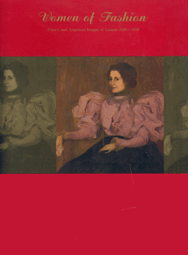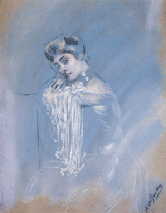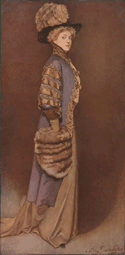





 Women of Fashion - Ed. Art Life Ltd.
Women of Fashion - Ed. Art Life Ltd.
Weisberg, Gabriel P.
16 mars 1994
"(...) Through the elegant visualizations of Antonio de La Gandara, another member of the group of French artists discussed here, the quality of feminine grace developed into an all-abiding principle. His works helped define the nature of official portraiture at exhibitions throughout the 1."
"Antonio de La Gandara (1861-1917)
The son of a Spanish father and an English mother made Antonio de La Gandara sensitively aware of artistic currents in both countries and to influence that could lead to new ideas. There is little doubt, that in La Gandara’s portraits of fashionable women, he was often under the influence of painters such as James McNeill Whistler, and later Jacques-Emile Blanche – artists who helped La Gandara achieve a delicate tonal effect in his compositions.
From the beginning of his career, La Gandara was also aware of the academic tradition as he was trained in the studio of Jean-Léon Gérôme. He carried this artistic baggage into work that he exhibited at the Salons where he received an honourable mention in 1884. In 1889, at the time of the Paris World’s Fair, La Gandara received a bronze medal, and in 1900 he was awarded the more prestigious silver medal. Throughout the 1890s, in works shown at the Salons of the Société Nationale des Beaux-Arts, La Gandara set a tone of elegance and finesse in his large scale portraits of women and their children. Often La Gandara set his scenes in the Luxembourg gardens, a convenient place where the wealthy could spend their leisure hours and where their children could play under their watchful eyes. Antonio de La Gandara’s imagery reiterates the qualities of graciousness and elegance that were also reflected in the high style clothes and poses that his models took in their compositions. La Gandara had an extensive clientele among the wealthy elite of Paris who wanted to have their portraits painted by an artist who could mirror the genteel grace of this type of society.
 As a principal portraitist during the 1890’s, and an artist involved in the revival of the pastel medium, Antonio de La Gandara combined both of these interests in this work. The model, which could be a portrait of his wife, is observed in a casual pose that allows the lace ruffles of her sleeves to fall in cascading ringlets for her shoulder. In this way, the model’s features are of secondary importance as the ruffles garner all the attention of the viewer.
As a principal portraitist during the 1890’s, and an artist involved in the revival of the pastel medium, Antonio de La Gandara combined both of these interests in this work. The model, which could be a portrait of his wife, is observed in a casual pose that allows the lace ruffles of her sleeves to fall in cascading ringlets for her shoulder. In this way, the model’s features are of secondary importance as the ruffles garner all the attention of the viewer.
The general blue tonality to the work, where the white pastel functions as a very positive element, demonstrates that La Gandara (similar to James McNeill Whistler) tried to suggest mood states through the overall use of a colour tone. The sophistication of handling the pastel in this manner further accentuates the degree of technical proficiency of the artist.
 As a well-known painting from Antonio de La Gandara’s later period, his Portrait Of Romaine Brooks demonstrates a close awareness of the popular artist whose work and bohemian existence contributed towards establishing her as one of the primary members of the American expatriots [sic] in Paris. A member of a cosmopolitan circle of writers, painters, collectors and intellectuals, Brooks attracted such stalwart members of the avant-garde as Jean Cocteau, Gabriele d’Annunzio, Anna de Noailles and Robert de Montesquiou whose works were heatedly discussed by various factions of the intelligentsia both in France and other European centres. Antonio de La Gandara albeit linked with an older group of painters, and with a more traditional way of working, was taken by Brooks verve and presence; this portrait from around 1905 suggests the elegance of Brooks personality while presenting the artist almost in the guise of a classical muse (holding a painter’s palette) and dressed in a modish manner including a long flowing skirt suggestive of a Greek tunic.
As a well-known painting from Antonio de La Gandara’s later period, his Portrait Of Romaine Brooks demonstrates a close awareness of the popular artist whose work and bohemian existence contributed towards establishing her as one of the primary members of the American expatriots [sic] in Paris. A member of a cosmopolitan circle of writers, painters, collectors and intellectuals, Brooks attracted such stalwart members of the avant-garde as Jean Cocteau, Gabriele d’Annunzio, Anna de Noailles and Robert de Montesquiou whose works were heatedly discussed by various factions of the intelligentsia both in France and other European centres. Antonio de La Gandara albeit linked with an older group of painters, and with a more traditional way of working, was taken by Brooks verve and presence; this portrait from around 1905 suggests the elegance of Brooks personality while presenting the artist almost in the guise of a classical muse (holding a painter’s palette) and dressed in a modish manner including a long flowing skirt suggestive of a Greek tunic.
Romaine Brooks eventually gave this painting to Mme. de Gramont, a member of a rich aristocratic French family, as a token of friendship and respect**. Since Brooks had painted a portrait of Mme. de Gramont herself (a work now in the collection of the National Museum of American Art) the fact that both pictures were in the same collection, and were often admired by visitors to the salons of Mme. de Gramont, suggests that La Gandara had been the right choice to create a portrait that would idealize the American painter and place her within the symbolic context that had direct links with a traditional heritage. The painting was well-known during the second decade of the twentieth century; it was reproduced in the prestigious Les Arts (1919), thereby establishing its significance and demonstrating that both La Gandara and Romaine Brooks had an extensive following in genteel society as well as in the circles of the intelligentsia at the time of World War I.
 Antonio de La Gandara, one of the principal portraitists of women during the 1890s and the first decade of the twentieth century, was strongly influenced by the canvases of his idol James McNeill Whistler. La Gandara often posed his elegantly dressed women against a spare interior, often a blank background, in order to emphasize the woman’s pose and the rich and elaborate dress she wore. Since most of his portraits were of an exceptional size, it intimates that La Gandara was completing compositions destined to be displayed in the collections of wealthy patrons who possessed large and well-appointed homes. The creation of an aura of gentility and refinement, similar to the way in which English portraitists such as Thomas Lawrence or Thomas Gainsborough had functioned in the eighteenth century, became a hallmark of the artist. It was as if he was deliberately reviving a type of court or aristocratic portrait style for an upper-class following and audience.
Antonio de La Gandara, one of the principal portraitists of women during the 1890s and the first decade of the twentieth century, was strongly influenced by the canvases of his idol James McNeill Whistler. La Gandara often posed his elegantly dressed women against a spare interior, often a blank background, in order to emphasize the woman’s pose and the rich and elaborate dress she wore. Since most of his portraits were of an exceptional size, it intimates that La Gandara was completing compositions destined to be displayed in the collections of wealthy patrons who possessed large and well-appointed homes. The creation of an aura of gentility and refinement, similar to the way in which English portraitists such as Thomas Lawrence or Thomas Gainsborough had functioned in the eighteenth century, became a hallmark of the artist. It was as if he was deliberately reviving a type of court or aristocratic portrait style for an upper-class following and audience.
In this canvas, which has been identified first as the Portrait of Mlle D…, as well as that of the artist’s wife Thérèse Pierat, La Gandara has focused on the richness of the sleek dress, the quality of various textures and the importance of secondary accoutrements (the large hat or the fur muff). The muff, used to keep the hands warm (and the standard symbol of class) dominates as the model gently glides into the theatrical spotlighting. The illumination of her face betrays a slightly haughty expression; La Gandara provides the effect of psychological awareness to a model who is meant to convey an air of aloofness. As an example of upper-class portrait, and as an example of the artist’s best works, this canvas is delicately nuanced and technically advanced.